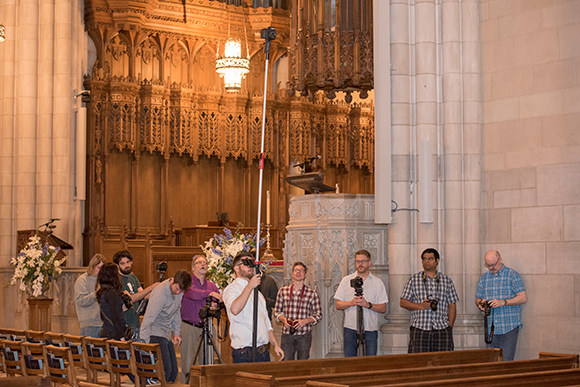Crowdsourcing a Virtual Duke Chapel
Students, architectural historians use chapel to turn 2D photos into 3D models
A group of photographers led by Edward Triplett of the Wired! Lab built a virtual three-dimensional model of the Duke Chapel using photogrammetry.
Since re-opening on May 11, Duke Chapel has welcomed thousands of visitors, many bringing cameras to capture the sights.
But on a rainy Tuesday last week, one group moved through the chapel taking pictures with a different purpose. Unlike the usual tourists, gazing up, snapping a picture, and moving on, they moved with precision: Snap a picture. Take one step to the side. Snap another picture.
Some photographers knelt on the floor and angled their cameras up toward the ceiling, while others balanced their cameras on the tips of painter’s poles like very long selfie sticks.
The group, a collection of Duke architectural historians, archaeologists and archivists, wasn’t there to capture beautiful photos. They were there to practice photogrammetry -- a technique for building virtual three-dimensional models based on detailed photos -- and to document the chapel at this unique point in its history.
“With the restoration complete, we are trying to get a nice three-dimensional snapshot of all the work that has been done,” said Edward Triplett, a CLIR post-doctoral fellow at the Wired! Lab who led the workshop. “In the future, if the molding is deteriorating or we need to make some kind of repair, we will actually have a three-dimensional picture of what that piece of stone really looked like.”
Triplett calls photogrammetry “the reversal of photography;” instead of trying to capture our three-dimensional world on a two-dimensional canvas, photogrammetry uses two-dimensional photographs to virtually reconstruct our three-dimensional world.
The aim is to collect systematic and clean data. A photo series for photogrammetry should have uniformity in light, exposure and composition, so that pattern-recognition software has consistent details to reference as it constructs a three-dimensional model.
Below: A preliminary point cloud shot from 250 photos at Duke Chapel. A more complete model will follow soon.
An architectural historian, Triplett has used photogrammetry to construct 3D models of historic buildings, from a chimney at Thomas Jefferson’s Monticello to ruined fortresses in Spain.
“This is a new way of preserving cultural heritage,” said Mark DeLong, director of Duke Research Computing. “Ideally, at the end of the day we would like to have all of the data and a rough draft of what the inside of the chapel looks like.”
In addition to documenting the chapel, the workshop was held to introduce photogrammetry to Duke faculty and graduate students – some of whom are preparing to use this technique to study architecture and archaeology at field sites in Italy and Spain this summer.
“We have students who can use a digital camera pretty well, but it’s a different process to actually use it inside a building and go through it,” Triplett said. “We can very easily create holes unless we approach it in a very regimented, ritual way.”
After two hours at the chapel and more than 3,000 shutter clicks, the group headed to the Wired! Lab in Smith Warehouse for a tutorial on the photogrammetry processing software.
For the tutorial, each participant started with only 25 to 50 of their own photographs – anymore and they might overload the powerful desktop computers they were working on.

During the photogrammetry workshop, photographers and students prepare to photograph the chapel interior. Photo by Reagan Lynn/Duke Photography
Within half an hour of processing time, different corners of the chapel began popping up on screens with color and lighting so vivid that you could tell which side of the chapel the person was working on, based on the quality of the sunlight peering through the windows.
“Photogrammetry has been around a long time, but they used to do it by hand so it was a lot more labor-intensive,” Triplett said. “But the algorithms and the graphics processors are really spiking in terms of power – we can reconstruct every nuance, every fold, every mold of the surface of the building.”
As a next step, Triplett will collect all of the photos taken during the day to create a 3D model of the whole building using a computer cluster recently acquired by the Research Computing center.
“I’ve been at sites where I’ve taken 20,000 photos, but never in such a concentrated space, and never this quickly,” Triplett said. “It could potentially be a lot more data than we need. But, like a lot of crowdsourced projects, people can approach it in a lot of different ways. It will be interesting to see what people missed.”
“The process of change has accelerated during my lifetime, but along with this acceleration has also come the technology to help us understand the material world better,” DeLong said. “These new technologies are letting us capture and understand our surroundings, even when they are completely in flux.”